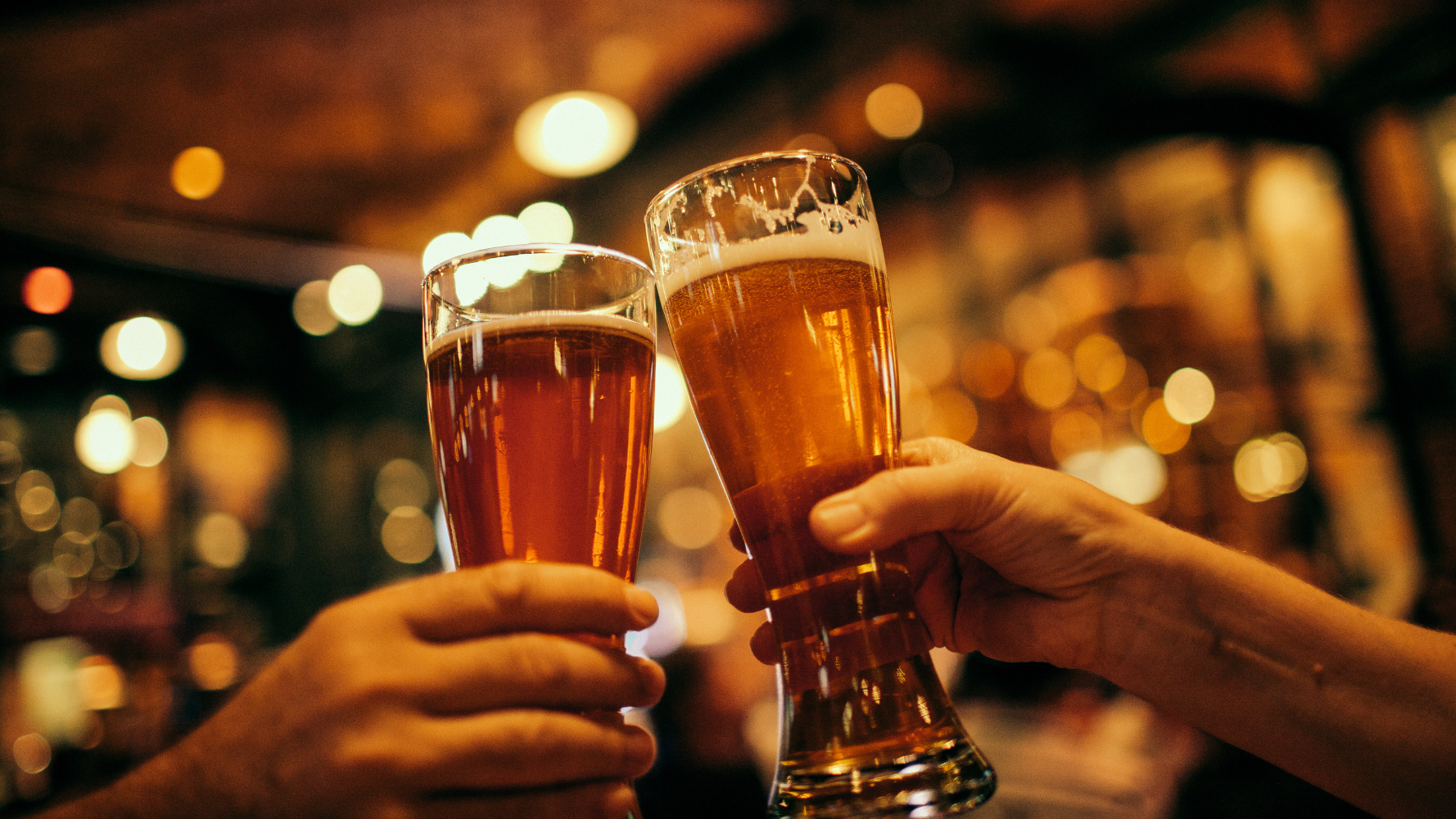Retailers toast the booze-free boom: Nonalcoholic beverages are big businessRetailers toast the booze-free boom: Nonalcoholic beverages are big business
As consumer demand rises, retailers tap into the growing nonalcoholic beverage market with innovation and strategic merchandising. See what they are doing.

At a Glance
- Nonalcoholic beverage sales soar, driven by drinkers seeking moderation.
- Younger generations fuel the rise of nonalcoholic beers, wines, and spirits.
- Quality and innovation are key to sustaining the nonalcoholic drink market.
Spend time reading about the burgeoning nonalcoholic beverage movement, and behold a rousing cacophony of clinking glasses and shouts of cheers. From Gen X on down, people are stepping—if not leaping (stumble-free!)—away from full-test hooch.
During this year’s Dry January, 54% of adult Americans who already hit the sauce reported they were “somewhat” likely to participate in the annual booze-free challenge, according to a new report from CivicScience. That number is up from 46% in 2024.
The figure may rise even more next year, especially if the Food and Drug Administration acts on the Surgeon General’s call for cancer warning labels on alcohol products.
When people turn to alcohol stand-ins today, regardless of whether to fulfill a Dry January pledge or transform a lifestyle, they’re not replacing the hard stuff with just the OG options—seltzer water or soda. Instead, they’re gravitating toward new nonalcoholic (NA) products. What was a trickling creek of them just a few years ago today amounts to a wild, sloshing river.
Bottoms up, brands! And sláinte to retailers, too—it’s not often that a buzzy and entirely new food or beverage category emerges and begins prying open wallets.
Alcohol retailers lead on sales strategies
For insights into the category, I chatted with Brian Gelb, vice president for wine and nonalcoholic at Total Wine & More. Within the NA industry, Total Wine is often championed as a leader. Grocery retailers face different challenges than liquor stores, but by most accounts, the same kinds of customers are buying these products, regardless of the store.
Nationally, 94% of people who buy NA products also drink booze, according to Marcos Salazar, chief executive officer of the Adult Non-Alcoholic Beverage Association (ANBA).
“That’s what’s driving the category—people who already drink,” says Salazar. At Total Wine, Gelb says that 80% of NA customers also pick up booze while strolling the aisles—few swing by a Total Wine store to shop exclusively for nonalcoholic bottles.
For most, Gelb said, they’re buying for home entertaining, when they know a non-drinker is coming over. Or for a pregnant wife or daughter. They’re also exploring the products to moderate their own drinking habits. “When people drink today they are a lot more conscious about what they are drinking, and how much. They’re using these products to moderate,” he says. “A lot of the younger generations don’t want to sleep until noon, wake up with a hangover and waste half their weekend.”
The company’s NA set has grown quite a bit. It wasn’t long ago that beer held the vast market share of Total Wine’s NA products. But during the past three years, Gelb says, the rest of the categories—wine, spirits and RTD beverages—have grown as much as 30% annually.

Relentless focus on quality essential
The surge of new hangover-free IPAs, RTD virgin Negronis, booze-less pinot noir and liters of zero-proof gin is establishing coveted spots on Total Wine shelves. The trick, of course, is remaining there. One key to success, Gelb says, is a relentless focus on quality.
After all, it’s drinkers with vast experience in traditional alcohol who are buying the products. They understand flavors and textures in alcoholic beverages. For the new frontier of NA beverages to secure a permanent place on shelves, quality must continue its upward trajectory. Gelb says beer is far ahead on the quality front. Companies in the sector have been crafting NA suds for decades. And now, quality is improving, dramatically so, compared to the offerings of just five years ago.
Wine, spirits and RTD beverages trail beer’s quality benchmarks. But they’re coming along. Gelb thinks it’s just a matter of time before ambitious R&D leads to Malbecs with body, to whiskeys that taste like a night before a roaring fire, for RTD beverages that drift away from sweet profiles and incorporate more cocktail-inspired bitter notes.
The canned mocktail category intrigues Scott Scanlon, executive vice president, alcoholic beverages at data analytics firm Circana. He’s been tracking NA's heady rise, and finds mocktails especially help people feel like they are having a “premium drink” experience. They’re also resonating with younger consumers—vital for both brands and retailers.
“The alcohol companies are making sure they are attracting younger generations. If they can bring them in through mocktails, they’re expanding,” he said. “It fills a gap. We all lived through craft beer. So what is taking its place now, because craft beer is in decline? We should consider this set as something consumers can lean into.”
For beverage pros at traditional alcohol stores like Total Wine, tastings are a big part of the job. Buyers sip through booze all day, nearly every day—there’s lots of on-the-job spitting. Natural and organic industry retailers, too, must think like booze buyers and approach these products with a critical palate. It doesn’t take many $16 four-packs of RTD “gin and tonics” that taste like glass cleaner (sadly, I can attest to this) or $30 bottles of spirit-free rye lacking zest to dispirit even the most open-minded consumers.

Smart merchandising drives sales
Merchandising matters, too. At Total Wine, all NA products dwell on a dedicated series of shelves. For natural and organic retailers, savvy merchandising experts recommend placing the NA products near alcoholic bottles and cans. As it’s booze drinkers who mostly buy the hooch-free brands, retailers should make sure those dry dark rums are within view of the saucy shelves.
It thrills me to share toasts with the industry’s many celebrants. They enjoy reasons to beam. The industry has come a long way. Growth is spiking—up by anywhere from 18% to 36% in 2023, depending on the NA category.
Meanwhile, increased demand for the products has attracted the traditional booze industry—especially beer juggernauts. But it’s not just the hops-and-barley crowd on the receiving ends of batted eyes. Among other developments, last year Moët Hennessy acquired NA sparkling wine brand French Bloom; Pernod Ricard purchased a minority stake in Almave, an NA spirits brand co-founded by Formula 1 driver Lewis Hamilton; and Diageo purchased a majority stake in Seedlip, an NA spirits pioneer.
All of this category effervescence is attracting focused attention from retailers. In the 39 states where alcoholic products of some stripe can be sold in grocery stores, the NA boom offers not only sales potential, it also could attract new customers to stores.
“My hope for 2025 is we continue to see new ideas and more differentiation,” says Gelb. “We see a lot of things that already exist on the shelf. How many N/A Chardonnays or margaritas in a can do we need? I’d love to see continued innovation—the industry needs to excite people to try the category. If they like what they sip, they’ll be back to buy more, and to explore the shelves.”
Scanlon also stresses that innovation will be key for sustaining growth and bringing in new customers.
An innovation slow down is inevitable, he says, “but we aren’t there yet.”
“We have a runway of one or two years and even beyond,” he says. “It can really grow in tandem with consumers’ desires for healthier lifestyles.”
Cheers to that.
Natural Products Expo West, the leading trade show in the natural, organic and healthy products industry, is open March 4-7 at the Anaheim Convention Center in Anaheim, California. Nonalcoholic and wellness beverages will Click through for the agenda, registration, travel information and more. Subscribe here to receive updates.
Read more about:
Shelf LifeAbout the Author
You May Also Like





